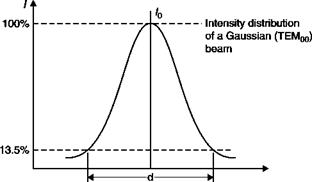Principle of operation
 |
A laser source is made with materials and construction techniques similar to those used for vacuum tubes (Figure 4.2). In it a current of plasma is generated since electrons are attracted by the anode and ions are attracted by the cathode. A capillary tube with a diameter of 1 mm is inserted into
the central part of the tube. To turn on the lasers, a starter is needed that allows the initiation of the arc that is then supported only by the power supply.
If the kinetic energy of electrons, depending on the difference of potential between the electrodes, is sufficient, one or more electrons of the atom move to a higher energy level in the collision with the ions, this phenomenon is called pumping. The electrons remain in this state for some time and then randomly and spontaneously return to a lower energy level, emitting energy as photons (spontaneous emission); the color, or wavelength, l, of this radiation depends on the difference of potential energy between the two levels.
Radiation, emitted in all directions, is neither coherent nor monochromatic, as a result of the superposition of electromagnetic waves with different wavelengths. To obtain laser light from this radiation, two small mirrors are needed, normal to the axis of the laser, at either end of the capillary tube; the photons directed along the axis of the capillary, and only those, are subject to repeated (infinite) reflections provoking another phenomenon called stimulated emission: when a photon hits an electron, this is moved to a higher energy level, it returns to its state of equilibrium with the emission of a photon exactly in the same direction as what it has invested. There is thus a multiplication of photons of the same type in the direction of the line joining the two mirrors in the capillary tube, and this leads to the formation of a thin, intense beam.
To obtain useful laser light outside, one of the two mirrors, the said transmitter, is not totally reflective and allows the escape of a small percentage of the light present in the cavity of the laser.
From the standpoint of the wave theory, the laser operation is linked to the fact that standing waves are generated in its optical cavity only if twice the length of the cavity is an integer multiple, m, of the wavelength: 2L = ml. Since m is large (order 106), there will always be many wavelengths 1m satisfying this criterion for which the light emitted from a laser will consist of a range of frequencies (f = c/l where c = speed of light) separated by Df = c/2L. These extremely narrow lines of which laser light is made are the longitudinal modes.
Since the mirrors and the capillary diameters are not zero, standing waves at small angles to the axis of the cavity can also exist. This gives rise to electric and magnetic transverse modes (TEMnm). Most of the laser operates in TEM00 mode, which has a Gaussian intensity profile (Figure 4.3) that provides the minimum divergence and can be focused on the smallest possible spot. Because the laser beam is not bounded by a sharp edge, its diameter is defined as that where the light intensity drops to 1/e2 (» 13.5%) of its peak value.

 |
Gaussian distribution of light intensity in a section of the laser beam
The emission of radiation can be within a broad spectral range, or a single wavelength can be optimized. Argon emits in a wide range of wavelengths ranging from ultraviolet to low infrared (Figure 4.4): this is
![Подпись: Emission spectrum of argon Wavelength [nm]](/img/3131/image205_2.gif) |
Figure 4.4
because the atoms of an element have a limited number of excited states in which certain transitions from state to state, called allowed transitions, are more favored than others, called forbidden transitions. For a noble gas, a few dozen transitions are allowed: for argon, over 40% of the total power is emitted at a wavelength of 514.5 nm, which corresponds to the green color, more than 20% is emitted at 488 nm (blue), about 13% is emitted at 476.5 nm (purple).
In order to have emission of monochromatic light, it is necessary that the laser beam be purified from all radiation of wavelengths other than that required; this is achievable with the use of a prism that divides the rays allowing the choice of a particular color. With this system, much of the energy of total radiation will be lost; a more modern system, called a single-line operation, is equipped with a prism that selects the beam before it hits the total reflector, limiting the emission of photons at the desired wavelength.











